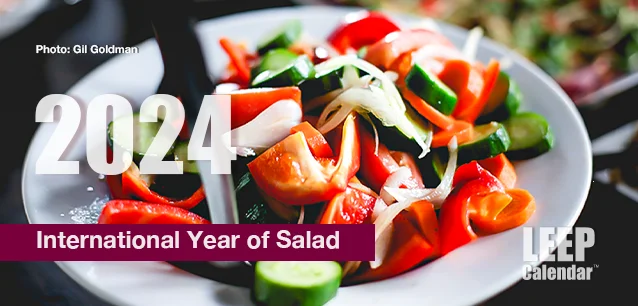 AD
AD
Today is: April 29
Scroll to explore events active on this date.
LEEP INK FEATURES

Events in April 2025
Spring has sprung in the north, and the first hints of Autumn are on the horizon in the south. April is the month spring (or fall) gets underway, and it is filled with religious celebrations, including the Mu...

Metamorphic March: Trends and events in March 2025
Welcome to Spring or Autumn. This is a transitional month with something for everyone. Internationally, it is Women's History Month, focusing on the achievements, needs, and challenges that women ...

February Favorites
The world steps into the second month of 2025 with hope and trepidation. The United States has a new administration. Canada is finding its way to a new administration. Germany and several other European nations...
About the International Year of Salad
Health , Retail
Ends: Dec 31, 2024
DESCRIPTION:
Each year one flower and one vegetable are chosen for focus by the Fleuroselect Home Garden Association. 2024 is the International Year of Salad.
Salad, a dish consisting of a mixture of small pieces of food, usually featuring vegetables, has a history that spans many centuries and cultures. Ancient Romans and Greeks ate mixed greens with salt, oil, and vinegar dressings. The word "salad" comes from the Latin "sal" (salt), which was a main ingredient in the dressings. By the Middle Ages in medieval Europe, salads evolved to include raw, cooked, and preserved vegetables mixed with various meats and fish. Salads were often served as a starting course to aid digestion.
During the Renaissance, salads became more elaborate, and chefs experimented with various herbs, flowers, and other ingredients. Advanced chefs designed salads to be visually appealing works of art.
As the world expanded through exploration and colonization in the 17th and 18th centuries, salads reflected the optimism in Europe. The French were particularly influential in refining salad dressings and compositions through courses; now, salads were usually served before the dessert.
With the industrial revolution of the 19th century and advances in health and nutrition, salads were considered healthy meals. The introduction of new vegetables from the Americas and the influence of different international cuisines contributed to the diversification of salad recipes.
By the 20th century, salads became a staple in Western diets and standardized through new recipes like the Cesar Salad, Jell-o salads, three bean salad, and Chinese Chicken Salad. In the 1970s, Salad bars began to appear in restaurants, allowing diners to customize their salads with various ingredients.
With the growing awareness of healthy eating and the emphasis on fresh, local, and organic produce, salads have continued to evolve. They can range from simple side dishes to full, gourmet meals with influences from various global cultures.
Salads can be hot or cold in modern cuisine and include virtually any combination of ingredients, from vegetables, fruits, nuts, grains, meat, or fish. Dressings and seasonings have also become more varied, with chefs continually experimenting with flavors and textures. Salads are a testament to human creativity in using available resources to create nourishing and appealing food.
VIDEOS
SUPPORTING DOCUMENTS
Currently, this event does not have supporting documents.
ADDITIONAL IMAGES
Currently, this event does not have supporting images.
Where would you like to go now?
 AD
AD


/footer-logo.svg)
